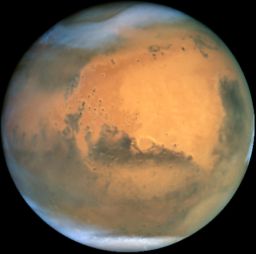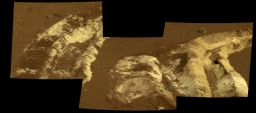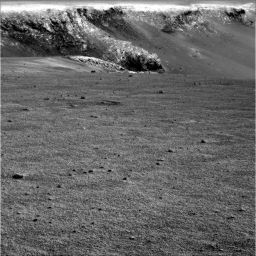A.J.S. Rayl • Feb 28, 2007
Mars Exploration Rovers Update: Spirit Gets Back Home (To Where It Once Belonged), Opportunity Completes 10K at Victoria's Rim
Dust storms are beginning to whirl around Mars as spring blooms in the southern hemisphere of the planet and along the equator where the Mars Exploration Rovers (MERs) are roving into their fourth year with a second banner month of exploration.
February seemed to fly by on Mars as Spirit finished up its remote sensing investigation of Tyrone, a combination of sulfate-rich white and yellow colored soil targets the rover churned up last year, in the Columbia Hills area of Gusev crater, and headed back to Home Plate. Along the way to the circular plateau that science team members generally believe now is an eroded-over volcano, the rover caught its first dust devil of the season just before Valentine's Day with its navigation camera almost by accident. Now, as it roams around Home, Spirit is employing its new WATCH software that was designed to help it more efficiently catch the ghostly apparitions that speed across the landscape.
On other side of the planet, Opportunity roved from Cape Desire around Bahia Blanca (White Bay) over to Cabo Corrientes on its voyage around Victoria crater in Meridiani Planum. As it drove this month, this rover traveled back into the spotlight by logging another "big milestone" when its odometer flipped over to 10,000 meters,10 kilometers. Considering that the MERs were expected -- or "warrantied," as principal investigator for rover science, Steve Squyres, of Cornell University, often puts it -- to drive 1,000 meters (1 kilometer) during the course of the mission, the achievement is significant. It also makes Opportunity the first rover to finish a 10K on Mars, establishing a new first for Martian rovers.
The story in large part for both Spirit and Opportunity in the next month and beyond will be about dust. Since 1 Martian year is approximately equivalent to 2 Earth years, the seasons on Mars last almost twice as long as they do here on the third rock from the Sun. For the rovers it means the dervishes of dust will be ominously swirling around their landscapes from now through mid-October. That can be a good thing and it could be a bad thing. The dust devils can bring both fortune and misfortune.
The Martian wind gusts that whip the dust into "devils," can actually extend the life of a solar-powered rover like Spirit or Opportunity by blowing dust off the vehicle's solar arrays, allowing more sunlight to penetrate the cells, and giving the robot field geologists an energy boost. In fact, the gusts are, in part, one of the reasons these 2 rovers are still roving, though most of the credit for their resilience and longevity goes directly to the designers and engineers who created them.
Other Martian gusts, however, could take a rover's life by enveloping it in a vortex of dirt and pressure. Even though most MER team members are doing double duty on Mars now -- Squyres, for example, is a member of the High Resolution Imaging Science Experiment (HiRISE) team on Mars Reconnaissance Orbiter (MRO), and deputy principal investigator for rover science, Ray Arvidson, of Washington University St. Louis, heads the Phoenix landing site team -- the sensibility that there is no time to waste is ever present on the MER mission. It could go either way at almost any time right now and each day is viewed more and more as a gift and the rovers have never been given short shrift by their ground teams.
For now, Spirit and Opportunity rove on. Each rover marked its 1,100th sol in February. Both remain in good health with all instruments continuing to function. Spirit suffered a setback earlier in the month when its instrument deployment device (IDD) failed to place instruments as programmed. The RPs at the Jet Propulsion Laboratory (JPL) where the rovers were built and are being managed -- and that stands for rover planners, not rover police -- declared the robotic arm, and hence the instruments it holds, out of commission and began analysis. Otherwise, the instruments on both rovers continue to defy the odds with every passing day.
While Spirit's IDD is under analysis, Opportunity's rock abrasion tool (RAT), which suffered a positioning failure last month, will soon be back in action. "We're getting ready to use RAT on Opportunity using a different sequence for making sure it is on the target and ready to grind," announced Bruce Banerdt, MER project scientist, of JPL, in an interview Monday. "They're using the motor current, which triggers a [telltale] condition in the software, to determine the RAT positioning and they're testing that out now," he said. "They'll start with brushing first, then get ready to grind again."
Although spring on Mars is the season of the dust, the Sun is rising higher in the sky and the temperatures are naturally rising, and both Spirit and Opportunity are witnessing increases in power levels. The average recorded temperature on Mars is -63° Centigrade (a beyond brisk -81° Fahrenheit). The maximum recorded temperature is 20° C (68° F) achieved in the heat of the summer around the equator, with a minimum of -140° C (-220° F) during the depths of winter in the coldest places on the planet. The rovers, notably, have survived 2 Martian winters. So with the beginning of spring on February 9, there was a cautiously-renewed optimism despite the looming dust storms that the rovers can keep on keepin' on at least for some months longer.
Spirit and Opportunity as robots, of course, are oblivious to any concern about their well-being and continue with a certain ease it seems doing what they were designed to do. Their agendas are replete with tasks of close-up investigations on selected rock and soil targets and lots of full-color pictures with the panoramic camera (PanCam). Nevertheless, the rovers are continuing to work in daily atmospheric studies that include measuring atmospheric opacity caused by dust with the PanCam, scanning the sky for clouds with the navigation camera, surveying the sky and ground with the miniature thermal emission spectrometer (mini-TES), and taking reference images of the sky.
As March blows in, both rovers will be circling their scientific prey: Spirit will begin a clockwise journey around Home Plate as Opportunity continues its clockwise voyage around Victoria.
Spirit From Gusev Crater
As January gave way to February, Spirit completed scientific studies of a target on a layered rock exposure known as Montalva on an outcrop called Troll, not far from its Winter Campaign site in the Columbia Hills region of Gusev crater. It then roved toward Tyrone, a patch of bright, yellow and white soils churned up by the rover's wheels last year as it was en route to Low Ridge to take seasonal cover.
 McMurdo pan labeled
McMurdo pan labeledDuring the last Martian winter, Spirit sojourned in Low Ridge, its winter haven, where the robotic geologist spent from late April 2006 into December 2006 parked on a north-facing slope in order to keep its solar panels pointed toward the Sun. During that time, while the rover spent the daylight hours conducting as much scientific research as possible, science team members assigned informal names to rock outcrops, boulders, and patches of soil commemorating exploration sites in Antarctica and the southernmost islands of South America. Antarctic bases are places where researchers, like the rovers on Mars, hunker down for the winter in subzero temperatures. During the past Martian winter, Spirit endured temperatures lower than -100 degrees Celsius (-148 degrees Fahrenheit. This full-color mosaic of images -- taken from the mission's largest panorama,the McMurdo pan -- was acquired by the rover's PanCam. It shows the various features of the landscape at Low Ridge and the informal names used to identify them. In recent weeks, Spirit hit the road and this month arrived back at Home Plate.Credit: Courtesy NASA /JPL-Caltech / Cornell
Following a rover-threatening spike over the New Year's weekend, the tau measurements -- or atmospheric opacity – or more simply, the amount of dust in the air -- held fairly steady in the Columbia Hills, between 0.55 and .65, meaning it was slightly dusty. Spirit's power levels are "still jumping around" between 300 and 350 watt-hours depending on the tau opacity on a given day. "That's fine for now. With spring, the air temperatures are coming up, which mean less of a load on our heaters, so it takes less energy to get through a day-night cycle," explained Banerdt. "The current range, actually, gives us quite a bit of margin."
In addition to its daily atmospheric observations, Spirit spent the first sols of February acquiring frames for dust devil movies with its navigation camera and investigating Tyrone from a safe distance with the PanCam and mini-TES. The RPs found a vista spot about 10 meters (33 feet) away for the rover to study the sandy patch in order to avoid getting mired in it as it had before arriving at Low Ridge for the last Martian winter. Since the rover is now limited to driving on 5 wheels, Spirit's handlers did not feel comfortable sending it any closer to the soft soils surrounding Tyrone. From this safe distance, the rover used its PanCam and mini-TES to determine its composition. The soils -- some of which the rover dragged to Low Ridge in its wheel well and studied during the Winter Campaign -- have been confirmed to be sulfate rich and possibly analogous to salty soils discovered by the rover much earlier in the mission.
Spirit studied 2 targets in the soil disturbed by the rover's tracks close-up with the instruments on its IDD. One was a white soil target, dubbed Mount Darwin, which it examined with its alpha-particle X-ray spectrometer (APXS), microscopic imager (MI), and PanCam. The other was Puenta Arenas, a pebble in one of its wheeltracks, which it imaged with the PanCam and MI.
"We did some PanCam and mini-TES of Tyrone proper and then did some IDD work in the old wheeltrack that had some bright stuff in it," Arvidson confirmed. "But there wasn't a whole lot of bright stuff. We confirmed that it was sulphate bearing, but we couldn't tell much else."
During scientific studies of Mount Darwin and Puenta Arenas in soil disturbed by the rover's tracks, Spirit's handlers noticed positioning errors in the placement of instruments on the rover's robotic arm. In response, they scheduled diagnostic tests for Sol 1110 (February 16, 2007). "The issue became that we couldn't deploy the IDD, because it wasn't getting placed the right distance from the sample," Arvidson informed. "It may be the cameras need to be calibrated, which is done regularly, or it may be something else."
The rover filled out the first week of February scanning a target known as Russkaya and the distant McCool Hill with the mini-TES, taking more PanCam images of Tyrone and full-color images of McCool Hill, then prepared to drive back toward Home Plate, the circular plateau that science team members now believe is an eroded over volcano. "We buttoned everything up and got ready to drive," said Arvidson.
Spirit began the second week of February, on Sol 1103 (February 8, 2007) taking pictures of Tyrone Vista, basically, the rover's view of the upturned soil known as Tyrone along with the surrounding terrain, then began the drive to Home Plate. The rover essentially retraced its tracks back toward Montalva, updating its knowledge of its position relative to the Sun en route as it logged approximately 8 meters (26 feet). It was slated to spend that weekend conducting remote sensing observations, but on Sol 1104 (February 10, 2007) Spirit experienced a "warm reset," which caused its computer to reboot. The rover went into auto mode, canceling activities for the weekend while it awaited instructions from Earth. This is the third time Spirit has experienced this anomaly that is attributed to a well-known condition in the flight software. [Opportunity has experienced it twice.] The rover's handlers sent new commands that activated the master sequence of activities for Sol 1107 (February 13, 2007) and Spirit was back in the saddle.
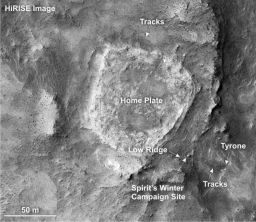 Spirit heads for Home
Spirit heads for HomeThis image from the Mars Reconnaissance Orbiter's High Resolution Imaging Science Experiment (HiRISE)camera shows the area in the Inner Basin of the Columbia Hills that Spirit is currently roving around. Home Plate, a circular plateau that the team believes is an eroded-over volcano and which the rover is currently exploring, is clearly visible.
Credit: Courtesy NASA / JPL-Caltech / Cornell
"We drove back between Troll and the Winter Campaign site and then turned right," said Arvidson. "We wound up after another drive right at the edge of Mitcheltree Ridge."
Spirit pulled up to Bellingshausen, "the very southern part of Mitcheltree ridge, the little nose of the thing," as Arvidson described it. There, it imaged the "nose" with the PanCam and looked at its mineral composition with the mini-TES.
On Sol 1109 (February 15), Spirit turned and drove toward a knobby rock dubbed Fabian, acquiring stereo images following the drive using the navigation camera. "Fabian is a knobby rock so we took pictures and acquired mini-TES data. Volcanic clastic rocks that are, explosive or granular can have big chunks in them and that's probably what Fabian is," Arvidson explained. The team was considering looking at it up close with some of the instruments on the IDD if the diagnostic tests turned up the problem and engineers got it resolved.
The IDD diagnostic test that has been previously scheduled for Sol 1110 (February 16, 2007) called for a "rover tai-chi." This "ballet" involves taking images of the contact ring of the Mössbauer spectrometer with the front hazard avoidance camera before placing the instrument on a target. Nothing seemed immediately obvious as to why it wasn't working properly. The rover planners are continuing to analyze those data.
The team had to make a decision: remain at Bellingshausen during the long President's Day holiday weekend while the engineers worked on the IDD issue in order to check out Fabian more intimately -- or plan for a day of driving on Sol 1114 (February 20, 2007) and get on Home.
The science team members decided to move "full steam ahead to Home Plate," as Arvidson put it. "We buttoned up about a week ago and began driving earnestly to Home Plate," he said in an interview Saturday. "We just didn't feel we wanted to spend the time at Bellingshuasen. We wanted to get driving to Home Plate so we could look at those more important rocks when the IDD is ready."
Before pulling out however, Spirit collected mineral data on targets known as Amhor, Bantoom, Dusor, Ghasta, and Gooli with the mini-TES on Sol 1112 (February 18, 2007) and on Horz, Hastor, and Invak on Sol 1113, and acquired more full-color PanCam images of Fabian and soil targets known as Kadabra and Kaol.
On Sol 1114 (February 20, 2007), Spirit rolled slightly backward, turned, and drove 8.61 meters (28.3 feet) toward Home Plate, searching for dust devils testing out its new WATCH software along the way. Later, after taking some post-drive images, the rover tested its WATCH to search for clouds.
Scientists are hopeful that the Martian winds that produce the dust devils will clear the accumulation of dust from Spirit's solar panels and boost the rover's power levels as they did at around this time last year. "We still haven't seen any cleaning events yet," Banerdt pointed out. "We're still waiting for that little miracle to happen."
In the meantime, the rover planners have refined their techniques and are getting more skilled at driving the 5-wheeled rover. All of Spirit's drives during the past week ended within centimeters (inches) of the targeted endpoint. "Things have been going amazingly well," Banerdt said. "Over the weekend, the RPs had a drive where they had to "thread a needle" between 2 rocks that were just a few centimeters apart – and the rover threaded right between them. The rover planners are getting really good at driving this rover with 5 wheels on the terrain that they're on, which is pretty well understood. Now when we get to slopes or looser soils, there will be more learning."
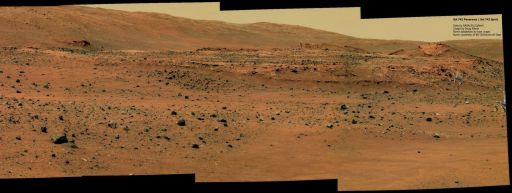 Spirit's position at Home Plate on Sol 746
Spirit's position at Home Plate on Sol 746Spirit approached Home Plate on Sol 743 and captured this color panorama of the elevated plateau. It then rolled toward the layered rocks over the next 3 sols. Two artist's renderings of the rovers are inserted into the panorama to show Spirit's position when it acquired panoramic views on Sol 746. By the end of sol 746, it had settled in to study the layered rocks with its instrument deployment device.Credit: Courtesy NASA / JPL / Cornell / D. Ellison / N. Schmidt
During the past week, Spirit finished its journey to Home Plate, driving 8 meters (26 feet) on Sol 1116 (February 22, 2007) and making the final tracks the edge of the circular feature on Sol 1118 (February 24, 2007). "The drive [Saturday] brought us up to the edge of Home Plate pretty much as we left it last year when we headed for McCool Hill and the winter campaign site at Low Ridge," said Banerdt. The rover also acquired westward-looking and northward-looking images after the drives, thermal data from a soil target known as Kabal using the mini-TES, and snapped various full-color PanCam images and managed to capture at least one more dust devil with its navigation camera.
On another drive Monday, Sol 1120, Spirit moved toward the eastern part of Home Plate The plan for the near future, Arvidson said, is to "take pictures, and collect mini-TES spectra, then begin a clockwise campaign where we ramp up onto Home Plate."
"We have good PanCam coverage of the edge of Home Plate, where we made the turn to McCool Hill last year, and we have another good image dataset of the layering somewhat to the north, so the idea now is to take a little jog to north to fill in that gap in between so we have high-resolution imaging of the exposed edges and face of this side of Home Plate," expounded Banerdt. "Once we finish that, we will head south and go up the edge to get back on top of Home from the southern edge."
At that time, the team will have to decide if Spirit will cross the diameter of Home Plate, roving radially toward the center and across the feature to look at what might be exposed. "If this feature is bowl-shaped, as the rover goes to the center, it will go higher and higher stratigraphically even though it's not going up in elevation," explained Banerdt. "That's one of the primary arguments for spending some time on top of Home Plate." There's no clear evidence of this stratification from MRO's HiRISE images. "But it could be there and just covered by surface dust," he suggested.
Roving across the top of Home Plate is one of the options. Ultimately, the science team members want Spirit to get to the northwestern edge and the western and southwestern parts of it, "the areas we have not explored yet," said Arvidson.
"Last year, we headed north in order to position ourselves to get to McCool Hill and get our tilt for the winter instead of going to the high-priority science targets at Home," elaborated Banerdt. "But the southwestern part is the highest, steepest exposure of Home Plate layering. We now want to go back now to those places with the best exposures from what we can see and do a really bang-up job of getting analysis on that."
Spirit's IDD remained under analysis as this update was posted. "There's no indication of any major problem, just this inconsistency between where they thought the arm was supposed to be and where it actually was," Banerdt said. "They gave a command for it to touch the ground and the IDD never really touched the ground and they've been investigating where in the chain of command that difference occurred."
Although the IDD and the instruments it holds remain off-limits to the science team for now, the rover will be fully utilizing its new WATCH to look for dust devils. "We now have WATCH command completely checked out and we're now trying to fit it in," said Banerdt. "We were bit limited on Monday and didn't have the capacity to store all the data. We've got a lot of PanCam images of Bellingshausen and Mitcheltree Ridge. Now with Home Plate, we have to keep memory available for PanCam images, so we're planning ahead. It's a daily balance between science imaging and imaging for mobility and the amount of memory available." As it turns out, Banerdt pointed out, that made it an ideal time to test and use the WATCH software, "because it doesn't return anything unless it finds something."
Now back Home, Spirit will turn the spotlight back in time once again . . . to the era of the American Negro League. Science team members will follow the tradition established during the first visit to Home Plate just about a year ago and choose pioneering baseball players from the league as namesakes for the targets of study. With Women's History month coming up in March, though, the men will get some competition. "We're about to introduce famous female players from women's baseball leagues, as namesakes too," said Arvidson. Stay tuned sports fans.
Opportunity from Meridiani Planum
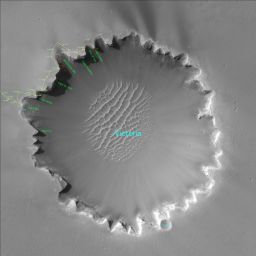 Victoria crater
Victoria craterMore than 3 years after embarking on an historic exploration of the Red Planet and 6.2 miles away from its landing site, Opportunity is roving around the rim of Victoria crater ridge by ridge, peering at layered cliffs in the interior. To identify various alcoves and cliffs along the way, science team members are using names of places visited by the 16th-century Earth explorer Ferdinand Magellan and his crew aboard the ship Victoria, who proved the Earth is round. This orbital view of Victoria crater was taken by the the High Resolution Imaging Science Experiment (HiRISE) onboard the Mars Reconnaissance Orbiter (MRO).
Credit: Courtesy NASA / JPL-Caltech / UofAZ
As February settled on Mars, Opportunity was driving around the edge of Cape Desire to different imaging locations, each about 2 to 3 meters (6.6 to 9.8 feet) apart to finish collecting long-baseline stereo images in the direction of Cabo Corrientes (to the east) and Cabo Anonimo (to the west).
"At each one of these points or peninsulas [or "capes"], we're doing a pair of images for each of the cross bay pans to get the stereo of each of these features," explained Banerdt. "We take pictures of the cape and then, move a couple meters to the side and do it all over again and that allows us to put together these high-resolution topographic maps of each of the features that form the scallops on Victoria's rim."
On the first sol of February, Opportunity conducted its daily atmospheric observations and "bumped" [moved a short distance] about 2.5 meters (8.2 feet) where it took some post-drive images. During ensuing sols that first week of the month, the rover used its PanCam to shoot full-color pictures for a mosaic in the direction of target Cabo Anonimo, the mini-TES to stare at its own tracks and scuffs in the soil then used the navigation camera to take images to support that mini-TES data, conducted another argon experiment by collecting 6 hours' worth of data with the APXS, and completed its remote sensing campaign at Cape Desire. The purpose of the continuing argon experiment is to determine the atmospheric mixing processes and track changes over time.
More analysis was completed on the data collected last month at what may be a meteoritic field -- and, true to form for this mission -- it is interesting. "What we know is that [Santa Catarina] had a composition similar to that of Barberton, which was a rock that we interpreted to be meteoritic and largely contained kamacite, a nickel-iron alloy," Squyres informed. "Santa Catarina did not contain kamacite, but it did contain troilite, which is another mineral commonly found in meteorites. So our suspicion is that Santa Catarina is also a meteorite," he concluded. He was "not prepared yet" to guess at a classification.
On Sol 1078 (February 4, 2007), Opportunity was ready to roll again and logged 42.81 meters (140 feet) as it drove away from Cape Desire, performing an update of its orientation with regard to the Sun during the sprint. Two sols later, on Sol 1080 (February 6, 2007), the rover drove 50.51 meters (166 feet). It was during this drive that the rover logged a mega-achievement when its odometer flipped over to 10,000 meters – the Big 10K [6.2 miles].
 10K and feeling fine
10K and feeling fineOpportunity logged 10K (6.2 miles) and set a new Martian driving record by crossing 50.51 meters (165.7 feet) of flat ground during a drive on its Sol 1080. This view -- a mosaic of frames taken by Opportunity's navigation camera -- shows the surroundings at the completion of the day's drive, which continued the rover's clockwise progress around the rim of Victoria crater (visible near the horizon. The mission was originally planned for 3 months, with a driving-distance goal of 600 meters (1,969 feet). Credit: NASA / JPL-Caltech
NASA requirements for mission success called for achieving at least 600 meters (1,969 feet) with one rover, and the goal of the mission design requirement was for 1000 meters (3,281 feet) or 1 kilometer, said Banerdt. It means, of course, that Opportunity is the first robot to journey 10 kilometers on Mars and right up through the last leg, the rover collected images for more color and black & white mosaics with its navigation camera and PanCam.
"This is another significant milestone for Opportunity, and yet another testimony to the outstanding work done by our development and operations teams," Opportunity mission manager Byron Jones said in the official announcement. Indeed – especially considering that the rover hasn't had the benefit of a mechanic or even routine hardware maintenance.
The washing-machine-sized robot field geologist has come a long way baby, since landing in Eagle crater, which turned out to be rich with evidence of Mars' watery past. In fact, Victoria crater was a massive impression that, on landing, was considered more dream than destination. But after nearly 2 years of driving (with many obstacles and exciting stops along the way), Opportunity is now roving Victoria's rim capturing some of the most stunning Martian vistas ever seen. But it's "not just there for the scenery," as Squyres noted earlier this month. "This thing provides a deeper, broader window into the subsurface of Mars and exposes more rocks than anything we could possibly hope to find with this vehicle. So, we've got this geologic treasure trove that we're just barely beginning to explore now."
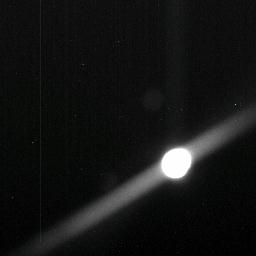 Phobos in passing
Phobos in passingOpportunity took this PanCam image of Martian moon Phobos during the second week of February and sent it home on Valentine's Day.
Credit: NASA / JPL-Caltech / Cornell
In the sols following it latest roving achievement, Opportunity made its way to Cabo Corrientes. As it roved, the rover checked out its new autonomous navigation software during one drive, conducted more NavCam and PanCam imaging to amass frames for mosaics, used its PanCam to view Martian moon Phobos and to conduct a horizon survey, and the mini-TES to conduct a 7-point analysis of sky and ground. During the afternoon Odyssey passes, the rover multitasked by using the mini-TES to complete a 5-point sky and ground analyses.
Opportunity's atmospheric observation routine generally calls for a PanCam tau measurement and a mini mini-TES sky and ground observation at the beginning of the plan and before the afternoon Mars Odyssey pass, with a mini-TES sky and ground observation during the orbiter's pass. In addition to these daily tasks on Sol 1084 (February 10, 2007), the rover used its PanCam to take full-color images of the target Santiago, then stowed its arm and drove 27 meters (89 feet) out onto Cabo Corrientes. After the drive, it took the standard pictures of its new location with the navigation and hazard avoidance cameras. At Cabo Corrientes, Opportunity spent the rest of the second week of February and most of the third imaging, as has been the pattern since beginning the voyage around Victoria crater's rim. From this vantage point, the rover focused on the north face of Bahia Blanca cliff walls and all angles of Cape Desire.
The theme of the names of the bays and capes of Victoria crater come from the places Magellan and his crew onboard the sailing ship Victoria visited during their circumnavigation of the world. Cape Corrientes is on the eastern coast of South America and was a useful landmark for Magellan’s fleet. Bahia Blanca (White Bay) is a huge bay in Argentina that Magellan explored looking for the Strait.
On Sol 1088 (Valentine's Day 2007), Opportunity used the navigation camera to look for clouds, the mini-TES to complete another 7-point sky and ground observation, the PanCam to take more full-color images of its surroundings. On the following sol, the rover stowed its arm and drove about 15 meters (49 feet) to get into position to image the other side of Cape Desire. After the drive, the rover unstowed its arm and took post-drive navigation camera images and completed a post-drive tau measurement.
Opportunity filled out its mid-month agenda by taking APXS observations to measure atmospheric argon, snapping images its PanCam mast assembly or “neck” and “head" to monitor for dust, and using the PanCam to image the Sun at midday. By the end of the third week in February, it was wrapping up its imaging work at Cabo Corrientes and preparing to "sail" onward, to the Cape of Good Hope.
"We are now going around Golfo san Matias and then we'll go out on the next promontory or point, which is Cape of Good Hope," Banerdt reported Monday. On the other side of Good Hope is a fairly wide bay that is not yet named, but it is "an interesting bay for a couple of reasons," he noted. "It is one of the bays that looks from preliminary data to have one of the more shallow slopes and may be a third possibility after Duck Bay and Bottomless Bay that would give us entrée into Victoria."
"We don't yet know whether or not it is a viable entry or exit alcove, since we have not seen it with Pancam," Squyres cautioned earlier today from Tucson, where he is attending a HiRISE meeting. "The HiRISE images, however, suggest that it could be a reasonable candidate -- as were Duck Bay and Bottomless Bay," he added.
The team has still not determined whether it's going into Victoria. "We're going to get images of this next unnamed alcove, and then we're going to sit down and start to talk about when and where we might enter the crater," Squyres said.
In the HiRISE images, this as yet unnamed bay on the other side of the Cape of Good Hope actually looks a little wider. "On the HiRISE images, you can see a dark streak coming from that bay and the one next to it, and heading north and a little to the west of those there are others that have streaks," Banerdt pointed out. "That's something of a lot of interest to the team. We want to understand the origin of those dark wind streaks."
"It could be dark sand that has been blown out of the crater," Squyres suggested. "Alternatively, it could be places where there has been selective stripping of fine-grained dust by locally enhanced winds," he pointed out. The MER team is planning a campaign to study one of these streaks, he said, once Opportunity gets over to that area.
For all the MER Updates, go to: http://www.planetary.org/explore/space-topics/space-missions/mer-updates/
The Time is Now.
As a Planetary Defender, you’re part of our mission to decrease the risk of Earth being hit by an asteroid or comet.
Donate Today

 Explore Worlds
Explore Worlds Find Life
Find Life Defend Earth
Defend Earth




